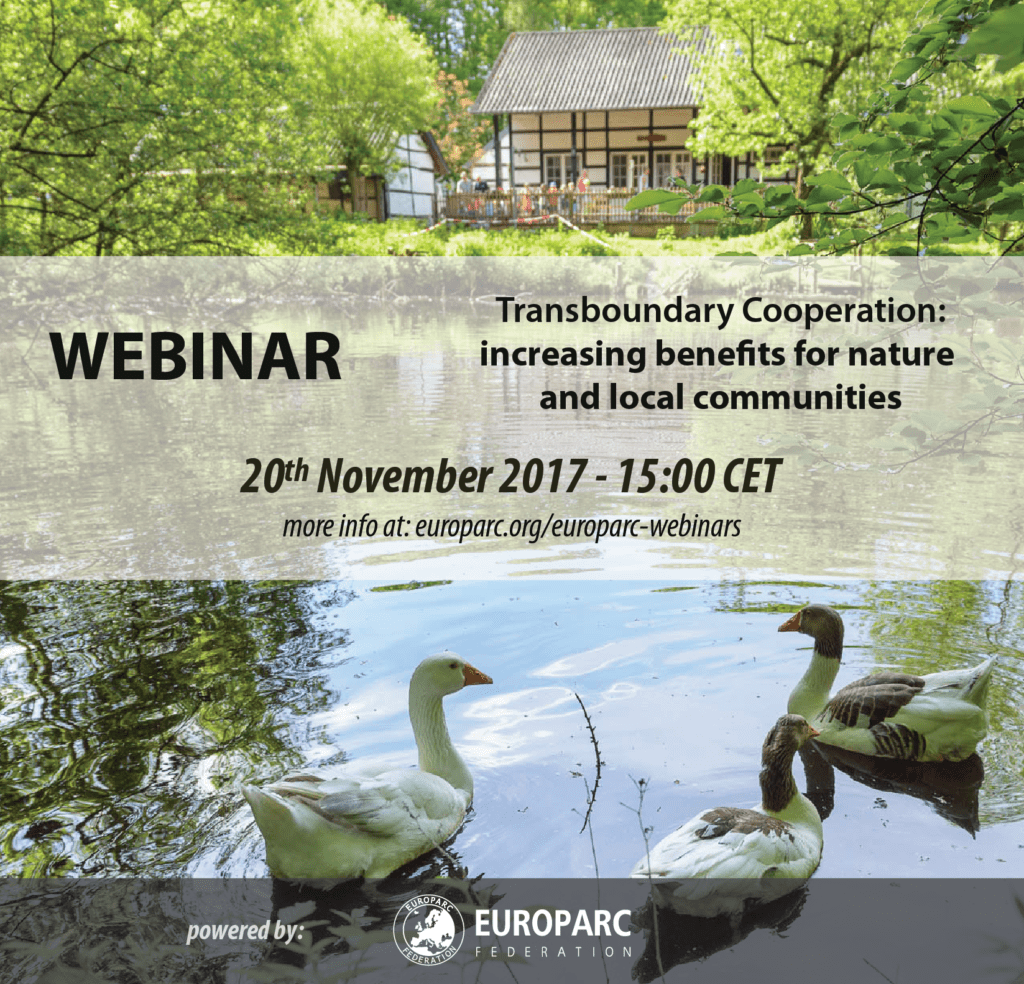Webinar: Transboundary Cooperation for nature and local communities
Photo: German-Dutch Nature Park Maas-Schwalm-Nette (DE-NL)
20th November 2017, 15:00 CET (Central Europe Time)
Europe is a complex continent with thousands of years of human interaction overlaying the natural world. The most obvious manifestations of that history are the many political borders that abound, and indeed change over time.
Nature, however, knows no boundaries. Across Europe, borders create artificial barriers to the management of valuable natural resources. Where Protected Areas share a common political boundary, cooperative management is fundamental if we want a stronger and natural Europe, with positive relations among countries within and outside the EU.
With this webinar, we will be looking at two examples of strong collaboration between 2 Transboundary Regions. How are they facing management challenges? How to actively involve local communities and authorities? Parks will share their daily experience working in a transboundary region, and showcase how cooperation benefits nature, cultural diversity, and the local economy.

Photo from the German-Dutch Nature Park Maas-Schwalm-Nette
Transboundary Parks: benefiting nature and local communities
The first case illustrates a trilateral cooperation between Finland, Norway and Russia, the Pasvik-Inari Trilateral Park. “Borders separate – Nature unites!” is the motto of this complex cooperation, that crosses the European Union borders. How to work collaboratively in a region encompassing five protected areas, and cultural diverse? What are the lessons learned?
The second case study reflects the importance of involving local communities by the German-Dutch Nature Park Maas-Schwalm-Nette. German and Dutch staff work everyday shoulder-by-shoulder, sharing office, projects and activities. We will hear about the creation of the Park, and how they are actively involving local communities, public authorities and volunteers in their activities.
The Webinar will be introduced by Stefania Petrosillo, policy officer at EUROPARC and responsible for the Transboundary Parks Programme.
Case Study 1
Together to protect the old taiga forest and promote dialogue, common understanding, and collaboration at the European Union borders’
by Riina Trevo, Specialist, Finnish representative in the working group of Pasvik-Inari Trilateral Park (FI-NO-RU)
Trilateral cooperation between Russia, Finland and Norway is about nature protection, management, environmental awareness, and promotion of sustainable nature-based tourism in the Pasvik-Inari region. Identified best practices are the solid bases for the cooperation. Five nature protection areas constitute the Pasvik-Inari Trilateral Park.

Pasvik-Inari Trilateral Park – left: Fishermen, Pasvik Zapovednik, Rajakoski nature school – right: Fugleregistrering i Pasvikelva, by Björn Frantzen – Bioforsk
About the Transboundary Area
Pasvik-Inari – a meeting point. Borders separate – Nature unites!
Pasvik-Inari Trilateral Park entity was established in 2008 as a result of long-term cooperation between the nature protection authorities in Norway, Russia and Finland dating back to early 1990’s. The Trilateral Park consists of five nature protection areas; three areas in Norway, one in Russia and one in Finland. The total area of Pasvik-Inari Trilateral Park is 1889 km2.
The lush valley of the Pasvik river stretches from Lake Inari in the south towards the Barents Sea in the north, appearing as a vital nerve in the mosaic landscape of small lakes, mires and wet lands and virgin Taiga forests. The region comprises a unique nature system where European, Eastern and Arctic species meet. Here, some of the species reach the ultimate limits of their distribution. The area is also an important nesting and resting place for a large number of migratory birds.
The Pasvik-Inari region is a meeting point for different cultures too. Different Sámi people live in the area: the Northern, Inari and Skolt Sámi. Since the Early Middle Ages, Finns, Norwegians and Russians have also settled in the region. Borders separate – Nature unites!
Although different cultures coexist in the area and have learned a lot from each other, they have each retained their distinctive traditions.
Case Study 2
Cultural and socio-economic benefits for cross-border communities, involving private and public stakeholders in common projects
by Silke Weich, Cross-border project manager, Nature park Maas-Schwalm-Nette (DE-NL)
Important in the transborder cooperation within the German-Dutch nature park Maas-Schwalm-Nette is the commitment of stakeholders on both sides of the border for common ideas and projects. This contains mutual understanding of cultural differences, appreciation of each other’s strengths and respecting each other’s weaknesses.
Successful projects will leave partners and stakeholders satisfied with the benefits of a project and with the intercultural relationships that have been raised favourably in a long-term scale. Therefore, not only the cooperation of the project partners needs to be supported but also society has to be involved in project actions.

Maas-Schwalm-Nette Nature Park – left: Theater in the Park, by A.Raedts ; right: Visitor Center, by M. Hectors
About the Transboundary Area
3 rivers, 2 countries, 1 office: the Transboundary Park whose managers work shoulder-by-shoulder
The Nature Park Maas-Schwalm-Nette is located on the border of the German federal state North Rhine-Westphalia and the Dutch province Limburg. Within 800 km2 rivers, forests, heathland, bogs and varied cultural landscapes make it a very special attraction. In the heart of the park lie 10.000 ha of forests and nature reserves of European importance (NATURA 2000).
After in 1965, the German Nature park Schwalm-Nette had been founded as an association of three districts in Germany, representing 17 communities, in 1976 the Nature park was enlarged to the German-Dutch Nature park Maas-Schwalm-Nette on behalf of a treaty between the Kingdom of the Netherlands and the state Northrhine-Westfalia. In 2002 the transborder association German-Dutch Nature park Maas-S(ch)walm-Nette was founded with a transborder project office including Dutch and German staff to manage bilateral activities and projects.
The EUROPARC Transboundary Parks Programme and Certificate “Following Nature’s Design” seeks to support protected areas in a process of mutual understanding, often between countries where history may have created mutual distrust, or administrative barriers and develop management tools to enable greater cooperative management.

23 European Protected Areas have been successfully certified as 10 Transboundary Parks ’’Following Nature’s design”.
- Get to know the Programme , discover the network and find out about our transparcnet meetings
Event organised by
